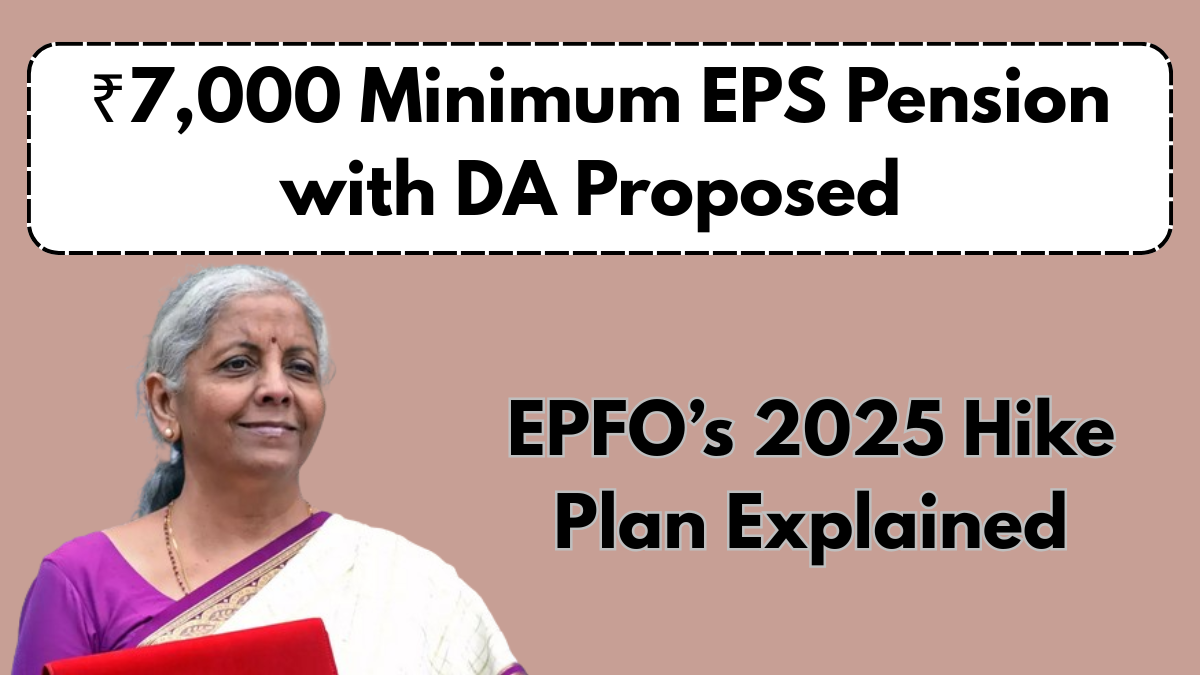In a move that could significantly improve the financial stability of lakhs of pensioners, the Employees’ Provident Fund Organisation (EPFO) is set to implement a substantial update in 2025. As per the latest eps hike news, the government is proposing to raise the minimum monthly pension under the Employees’ Pension Scheme (EPS) to ₹7000, along with dearness allowance (DA). This long-awaited decision aims to align pension payouts with inflation and current living standards.

₹7000 Minimum EPFO Pension 2025: What It Means for Retirees
The proposed ₹7000 minimum EPFO pension 2025 is not just a nominal revision. Currently, thousands of pensioners receive an amount as low as ₹1000 under EPS, which is widely seen as inadequate in today’s economic environment. This planned revision is intended to rectify years of stagnant pension payouts and offer a more sustainable income post-retirement.
Besides the base pension, the inclusion of pension with DA marks a critical shift. The dearness allowance will now be linked to cost-of-living adjustments, providing additional financial security as inflation fluctuates.
Breakdown of the Proposed Pension Structure
Here’s a simplified overview of the potential structure under the new EPS pension scheme:
| Pension Component | Existing (as of 2024) | Proposed (June 2025) |
|---|---|---|
| Minimum Monthly Pension | ₹1,000 | ₹7,000 |
| Dearness Allowance (DA) | Not Included | Included |
| Total Monthly Pension | ₹1,000 | ₹7,000+ (with DA) |
The revised pension is expected to benefit over 60 lakh pensioners, with DA calculated based on CPI-linked inflation data. This could bring parity with state pensions and boost overall morale among retirees.
EPFO Latest Update: Implementation Timeline and Process
According to the EPFO latest update released in June 2025, the pension hike is expected to roll out in phases starting from Q3 2025. A committee under the Ministry of Labour has already submitted a recommendation report, and the Union Cabinet’s approval is anticipated by August 2025.
Eligible pensioners will not need to reapply. Instead, the revised payouts will be adjusted automatically in their existing EPS accounts. For those approaching retirement in the current financial year, the updated pension with DA will be applicable from the month following their retirement date.
Key Drivers Behind the EPS Hike News
Several factors have converged to push this long-overdue reform:
- Rising Inflation: With daily essentials getting more expensive, the current pension is insufficient.
- Public Pressure: Retiree unions have consistently lobbied for a more realistic pension structure.
- Judicial Push: The Supreme Court’s observation on pension inadequacy influenced policy makers.
- Comparative Parity: Aligning EPS with other government pension schemes is seen as a corrective step.
The move also reflects the government’s broader commitment to social security reforms and senior citizen welfare.
Conclusion
The proposed ₹7000 minimum EPFO pension 2025 coupled with DA could be a game-changer for millions of pensioners in India. While the implementation hinges on upcoming government approvals, the direction is clear — a more equitable and inflation-adjusted pension system is on the horizon. Retirees and upcoming pensioners should stay updated with the official announcements to fully benefit from this transition.
FAQs
Who will benefit from the ₹7000 minimum EPFO pension 2025?
All EPS subscribers who are eligible for pension benefits will be covered under the revised scheme.
Will DA be revised regularly under the new plan?
Yes, DA will be adjusted periodically based on inflation and cost-of-living indexes.
Do pensioners need to submit fresh documents for the revised pension?
No, existing pensioners will receive the updated amount automatically.
What is the expected timeline for implementation?
The rollout is projected to begin by Q3 2025 after formal cabinet approval.
How is this different from past EPS updates?
Unlike previous minor adjustments, this proposal is a comprehensive hike with an added DA component.
Click here to know more.



